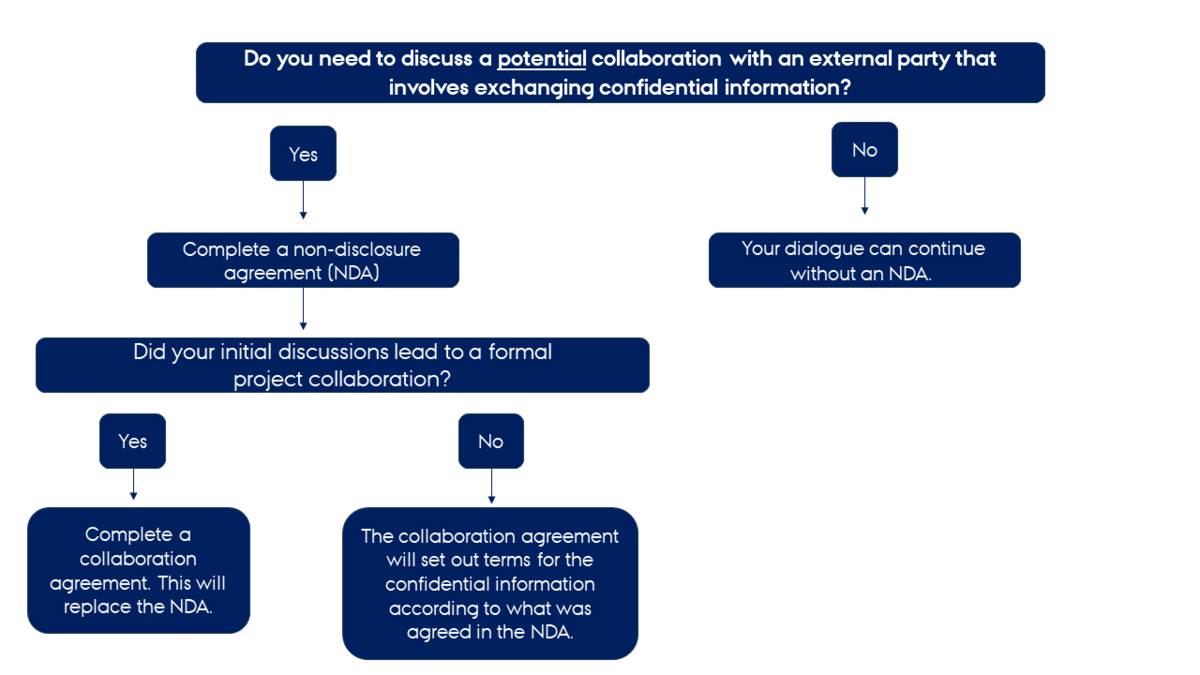Fast track Agreements
If you need to enter into a collaboration agreement with an external party, you can often use one of the TTO’s fast-track agreements, which contain standard, pre-approved legal terms.
Read more about the various fast-track agreements and download them on this webpage.
If your project involves clinical research or if you are unable to use one of our fast-track agreements, please contact the TTO for help.
How to use fast-track agreements
- Decide whether you need an agreement for co-financed or commissioned research.
- Download and fill out the highlighted fields/attachments in the fast-track agreement.
- Always download the fast-track agreement from this website, to ensure that it is up to date.
- As a general rule, the fast-track agreement must be signed by the head of department.
- Send a copy of the signed agreement to tto@au.dk
- Keep a copy of the agreement in your project folder as part of your contract management obligations.
If you wish to change any of the terms in the fast-track agreement, please contact the TTO.
Co-financed research
A co-financed research project is a collaboration between a university and at least one external party – an institution or a company – where both parties contribute equally to the project either in-kind and/or financially.
Use this fast-track agreement when:
- AU’s activities in connection with the project contribute to AU’s primary tasks and research purposes.
- Both parties contribute to the project, either kind (e.g. staff hours or resources) and/or financially.
!!Please note that you cannot use the fast-track agreement on co-financed research with a company if the project is funded by an external funding organisation. - AU’s research results belong to AU. Please note that a fast-track agreement with a company allows the external collaboration party to negotiate a license to AU’s results on market terms.
- AU may publish its own results and its co-owned research results.
Commissioned research and other income-generating activities (IV)
Commissioned research and other income-generating activities are services or assignments that an external party (such as a company, a public authority or an organisation) asks the university to perform on market terms. For example, a company may ask a researcher to perform an analysis, test or other specific task.
Use this fast-track agreement when:
- You perform a task for an external party within activity areas that are natural extensions of the university’s normal activities.
- Rights to the results directly connected to the commissioned task are transferred to the external party and the results may not be published by AU.
- AU receives payment from the external party on market terms (full direct costs plus the applicable overhead rate for commissioned research).
Unsure about the difference between co-financed and commissioned research?
In general, external parties can participate in two types of research collaboration with AU: co-financed research and commissioned research. The differences between these two types of collaboration relate mainly to the nature of the project, finance, rights and publication.
| Activities | Co-financed research | Commissioned research |
|---|---|---|
| Nature of the project | AU’s activities in connection with the project must support AU’s main tasks and must, as a general rule, support research and publication. | The activities must derive from AU’s general research activities and are, therefore, not central research tasks. |
| Finance | Both parties contribute to the project, either in the form of resources (staff hours) and/or financial support. | AU’s costs (including overhead) must be covered by the external party. |
| Rights | AU’s results belong to AU. AU may allow the external party to negotiate a license to AU’s results on market terms. | Rights to the results directly connected to the commissioned task can be transferred to the external party. |
| Publication | AU may publish its own research results and its co-owned research results. | AU may not publish results where the rights to these results are transferred to the external party. |
Other fast-track agreements
Non-disclosure agreement (NDA)
Download the Danish version of the agreement.
Before you discuss a potential collaboration with an external party in which confidential information will be exchanged, you need to sign a confidentiality agreement – called a non-disclosure agreement (NDA).
If these discussions lead to a project collaboration, you will often need to draw up a formal collaboration agreement with the external party. The NDA will then be replaced by the collaboration agreement.

Student project and internship
Download the Danish version of the agreement.
Use this agreement when you (the supervisor) has AU-students who need to collaborate with an external party as part of their studies or in connection with a project or internship. The agreement sets out the rights and obligations between AU (you as the supervisor), the students and the external party.
The supervisor must submit an electronic copy of the signed and fully approved agreement to the TTO.